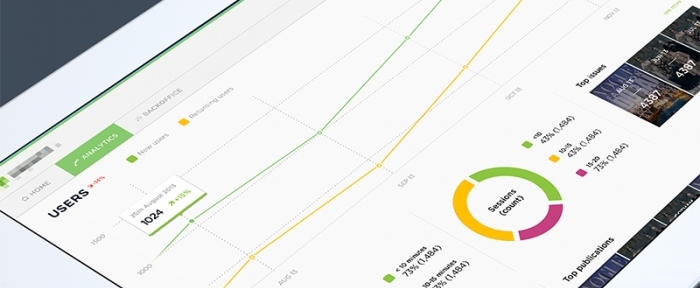Did you know that your website design actually has a lot to do with how well you rank on search engines? Did you also know that your website design can seriously interfere with you with your analytics? There are decisions along the design path that affect just how well your website meshes with analytics, and making the wrong decision could doom your website to obscurity. Here’s how to know which decisions you need to pay the most attention to and how to make sure you make the right decision:

Where Your Thank You Message Appears
You probably want to have your website say thank you to those who complete an on-page form, right? In what form does that thank you message appear? Is it right underneath the form they just used? Or are they taken to a separate page? If you just display a thank you message underneath the form, you are going to make tracking your goals extremely difficult. Sending them to a separate page where the message is displayed is a much better idea. This page is very easy to make and can then be tagged as the goal page. Once the user has reached that page, they have achieved the goal you wanted them to achieve. This makes them much easier to track, instead of having to match up form submissions with page visitors and guessing who made it where and when.
What Happens When a Page Visitor Signs Up for Your Email List
 When a visitor to your page decides to subscribe to your newsletter, what happens to them? Do they remain onsite, or are they taken to a page on a separate site? Just like with the thank you message issue, what you decide to do in this instance will seriously affect your ability to track your own goals. If you send them to a different domain, they have lest your website and it is impossible to track them, making it difficult to ascertain who is converting and who is not converting. And if they leave, analytics automatically marks that as a failure, even if they actually did subscribe once they left your page. Your best option is to not send them offsite when they sign up for your email list.
When a visitor to your page decides to subscribe to your newsletter, what happens to them? Do they remain onsite, or are they taken to a page on a separate site? Just like with the thank you message issue, what you decide to do in this instance will seriously affect your ability to track your own goals. If you send them to a different domain, they have lest your website and it is impossible to track them, making it difficult to ascertain who is converting and who is not converting. And if they leave, analytics automatically marks that as a failure, even if they actually did subscribe once they left your page. Your best option is to not send them offsite when they sign up for your email list.
Where Your Blog is Located
Some websites will have their blog on an entirely separate domain. Others will hide a link to their blog at the bottom of the page of their website. Others will display it alongside the rest of the navigation. How are you going to handle your blog’s location? If you make it a separate website, you are going to mess up analytics about where your traffic comes from and how long people stay on your site. It could also harm your ability to ranking, as interested traffic will be separated onto two websites. A subdomain is a good alternative, but it does not necessarily label what is and what is not blog content, which isn’t exactly bad, but it’s not good, either. Your final choice is to make it part of your directory. This is the best option for analytics and the best for SEO.
How Your Search Tool is Built
 If you have a search tool on your website, how does it function? When someone searches, does the search term show up in the URL of the results page? If yes, then you have made the right decision to get your website to mesh well with Google Analytics. If not, you are making it very difficult for this tool to be able to ascertain what terms are being searched for, how they are being searched for, and who is searching them. The only way to do this is if the tool can pull the search term out of the URL.
If you have a search tool on your website, how does it function? When someone searches, does the search term show up in the URL of the results page? If yes, then you have made the right decision to get your website to mesh well with Google Analytics. If not, you are making it very difficult for this tool to be able to ascertain what terms are being searched for, how they are being searched for, and who is searching them. The only way to do this is if the tool can pull the search term out of the URL.
The Flow of Your Design
Have you separated different topics onto one page or do you have just a single page, with sections for each topic? Analytics is going to prefer the first option. This makes it very easy to tell who is looking at what content and for how long. If all of your content is on one page, that content is only going to load once, and on matter where the visitor scrolls on the page, analytics is not going to be able to tell where that visitor is, what they are reading, or for how long they are reading it. While this might not be a bad thing, it definitely does not provide you with any significant insights about the behavior of the people who visit your website.
Did you know that your website design actually has a lot to do with how well you rank on search engines? Did you also know that your website design can seriously interfere with you with your analytics? There are decisions along the design path that affect just how well your website meshes with analytics, and making the wrong decision could doom your website to obscurity. Here’s how to know which decisions you need to pay the most attention to and how to make sure you make the right decision:

Where Your Thank You Message Appears
You probably want to have your website say thank you to those who complete an on-page form, right? In what form does that thank you message appear? Is it right underneath the form they just used? Or are they taken to a separate page? If you just display a thank you message underneath the form, you are going to make tracking your goals extremely difficult. Sending them to a separate page where the message is displayed is a much better idea. This page is very easy to make and can then be tagged as the goal page. Once the user has reached that page, they have achieved the goal you wanted them to achieve. This makes them much easier to track, instead of having to match up form submissions with page visitors and guessing who made it where and when.
What Happens When a Page Visitor Signs Up for Your Email List
 When a visitor to your page decides to subscribe to your newsletter, what happens to them? Do they remain onsite, or are they taken to a page on a separate site? Just like with the thank you message issue, what you decide to do in this instance will seriously affect your ability to track your own goals. If you send them to a different domain, they have lest your website and it is impossible to track them, making it difficult to ascertain who is converting and who is not converting. And if they leave, analytics automatically marks that as a failure, even if they actually did subscribe once they left your page. Your best option is to not send them offsite when they sign up for your email list.
When a visitor to your page decides to subscribe to your newsletter, what happens to them? Do they remain onsite, or are they taken to a page on a separate site? Just like with the thank you message issue, what you decide to do in this instance will seriously affect your ability to track your own goals. If you send them to a different domain, they have lest your website and it is impossible to track them, making it difficult to ascertain who is converting and who is not converting. And if they leave, analytics automatically marks that as a failure, even if they actually did subscribe once they left your page. Your best option is to not send them offsite when they sign up for your email list.
Where Your Blog is Located
Some websites will have their blog on an entirely separate domain. Others will hide a link to their blog at the bottom of the page of their website. Others will display it alongside the rest of the navigation. How are you going to handle your blog’s location? If you make it a separate website, you are going to mess up analytics about where your traffic comes from and how long people stay on your site. It could also harm your ability to ranking, as interested traffic will be separated onto two websites. A subdomain is a good alternative, but it does not necessarily label what is and what is not blog content, which isn’t exactly bad, but it’s not good, either. Your final choice is to make it part of your directory. This is the best option for analytics and the best for SEO.
How Your Search Tool is Built
 If you have a search tool on your website, how does it function? When someone searches, does the search term show up in the URL of the results page? If yes, then you have made the right decision to get your website to mesh well with Google Analytics. If not, you are making it very difficult for this tool to be able to ascertain what terms are being searched for, how they are being searched for, and who is searching them. The only way to do this is if the tool can pull the search term out of the URL.
If you have a search tool on your website, how does it function? When someone searches, does the search term show up in the URL of the results page? If yes, then you have made the right decision to get your website to mesh well with Google Analytics. If not, you are making it very difficult for this tool to be able to ascertain what terms are being searched for, how they are being searched for, and who is searching them. The only way to do this is if the tool can pull the search term out of the URL.
The Flow of Your Design
Have you separated different topics onto one page or do you have just a single page, with sections for each topic? Analytics is going to prefer the first option. This makes it very easy to tell who is looking at what content and for how long. If all of your content is on one page, that content is only going to load once, and on matter where the visitor scrolls on the page, analytics is not going to be able to tell where that visitor is, what they are reading, or for how long they are reading it. While this might not be a bad thing, it definitely does not provide you with any significant insights about the behavior of the people who visit your website.
Published on March 2, 2016

